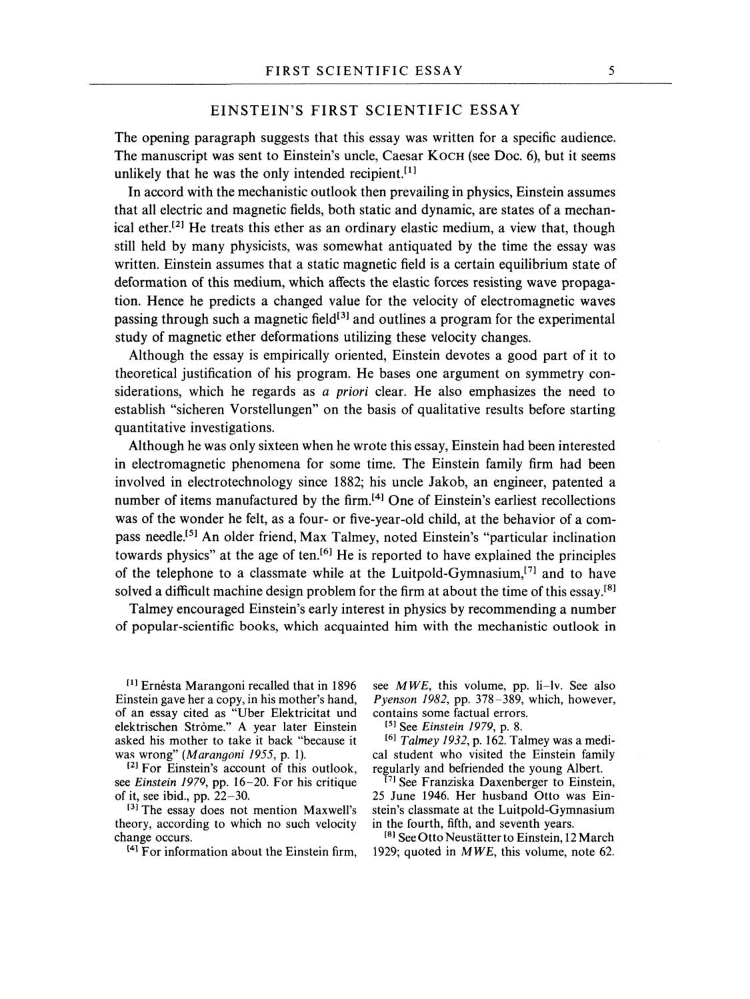FIRST SCIENTIFIC ESSAY 5 EINSTEIN'S FIRST SCIENTIFIC ESSAY The opening paragraph suggests that this essay was written for a specific audience. The manuscript was sent to Einstein's uncle, Caesar Koch (see Doc. 6), but it seems unlikely that he was the only intended recipient.[1] In accord with the mechanistic outlook then prevailing in physics, Einstein assumes that all electric and magnetic fields, both static and dynamic, are states of a mechan- ical ether.[2] He treats this ether as an ordinary elastic medium, a view that, though still held by many physicists, was somewhat antiquated by the time the essay was written. Einstein assumes that a static magnetic field is a certain equilibrium state of deformation of this medium, which affects the elastic forces resisting wave propaga- tion. Hence he predicts a changed value for the velocity of electromagnetic waves passing through such a magnetic field[3] and outlines a program for the experimental study of magnetic ether deformations utilizing these velocity changes. Although the essay is empirically oriented, Einstein devotes a good part of it to theoretical justification of his program. He bases one argument on symmetry con- siderations, which he regards as a priori clear. He also emphasizes the need to establish "sicheren Vorstellungen" on the basis of qualitative results before starting quantitative investigations. Although he was only sixteen when he wrote this essay, Einstein had been interested in electromagnetic phenomena for some time. The Einstein family firm had been involved in electrotechnology since 1882 his uncle Jakob, an engineer, patented a number of items manufactured by the firm.[4] One of Einstein's earliest recollections was of the wonder he felt, as a four- or five-year-old child, at the behavior of a com- pass needle.[5] An older friend, Max Talmey, noted Einstein's "particular inclination towards physics" at the age of ten.[6] He is reported to have explained the principles of the telephone to a classmate while at the Luitpold-Gymnasium,[7] and to have solved a difficult machine design problem for the firm at about the time of this essay.[8] Talmey encouraged Einstein's early interest in physics by recommending a number of popular-scientific books, which acquainted him with the mechanistic outlook in [1] Ernesta Marangoni recalled that in 1896 Einstein gave her a copy, in his mother's hand, of an essay cited as "Uber Elektricitat und elektrischen Strome." A year later Einstein asked his mother to take it back "because it was wrong" (Marangoni 7955, p. 1). [2] For Einstein's account of this outlook, see Einstein 1979, pp. 16-20. For his critique of it, see ibid., pp. 22-30. [3] The essay does not mention Maxwell's theory, according to which no such velocity change occurs. [4] For information about the Einstein firm, see MWE, this volume, pp. li-lv. See also Pyenson 1982, pp. 378-389, which, however, contains some factual errors. [5] See Einstein 1979, p. 8. [6] Talmey 1932, p. 162. Talmey was a medi- cal student who visited the Einstein family regularly and befriended the young Albert. [7] See Franziska Daxenberger to Einstein, 25 June 1946. Her husband Otto was Ein- stein's classmate at the Luitpold-Gymnasium in the fourth, fifth, and seventh years. [8] See Otto Neustätter to Einstein, 12 March 1929 quoted in MWE, this volume, note 62.
